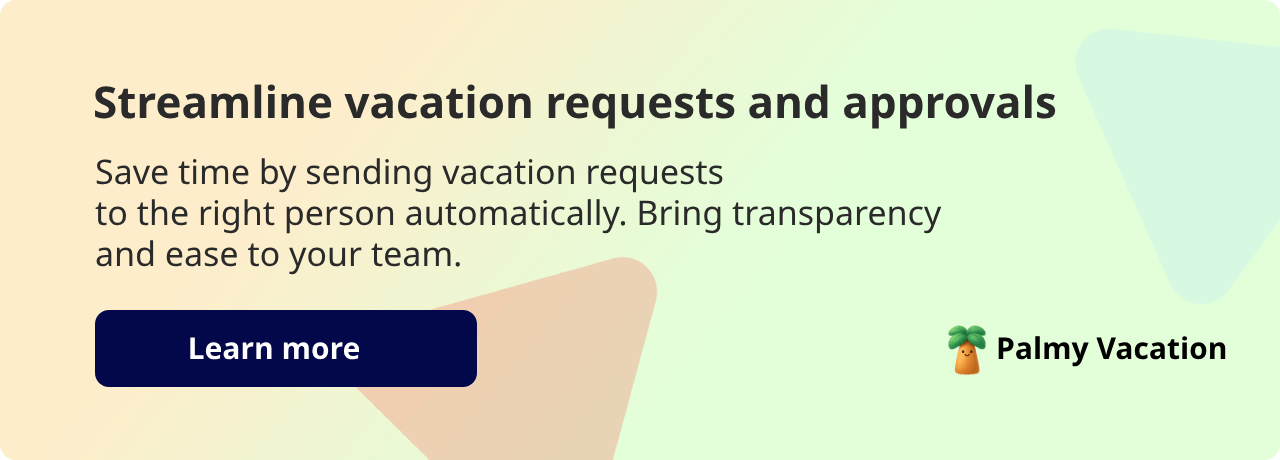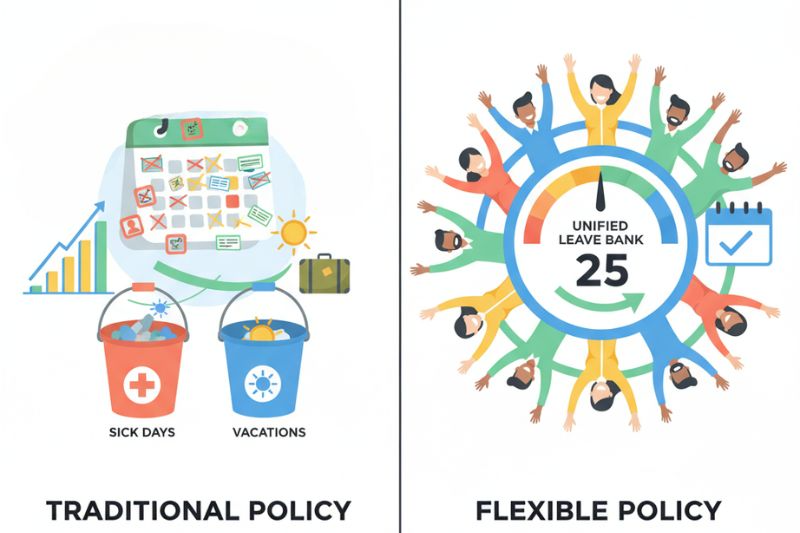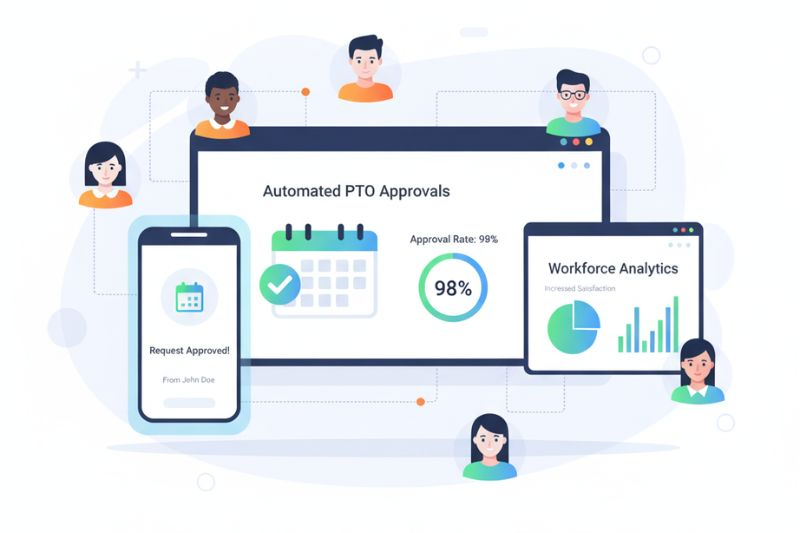What is flexible time off and how does it work?
Learn what flexible time off is, how it works, its benefits, drawbacks, and how to implement an FTO policy that improves employee well-being and retention.

Calls for better work-life balance and increased job satisfaction have revamped HR and workplace practices over the last few decades. However, there is one practice that has stubbornly persisted, and that’s traditional paid time off systems.

For the modern workplace, this approach often feels outdated. Flexible Time Off (FTO) offers an alternative that not only better meets the needs of employees but also simplifies HR processes. Let’s explore what FTO is and how it can meet the needs of your organization. You’ll find a short summary here 👇
Quick Overview
Flexible Time Off (FTO) is a powerful employee benefit and retention strategy that offers a single amount of sick leave, personal days, and vacation time off per year, providing employees with the choice of how to utilize these days. FTO policies offer a much broader approach to paid time off than traditional systems, and this makes it an attractive benefit for top talent.
Table of Contents
- How does flexible time off work?
- Benefits of a flexible time off policy
- Drawbacks of a flexible time off policy
- How to implement a flexible time off policy
- Conclusion
- Frequently Asked Questions
How does flexible time off work?

The modern workplace is a diverse ecosystem that requires employers to be more aligned towards employee well-being and engagement than ever before. A primary reason for this change has been an increase in remote employees - a situation that calls for flexibility and responsive management styles.
Flexible time-off policies are one avenue of adaptation to the modern workforce that can be easily implemented and managed. It works by consolidating all time off into one ‘bank account’, and empowering the employee to make the decisions about when and how to use it.
For example:
- Employee A on a traditional PTO system receives 15 days paid leave and 12 days sick leave per annum, but has to accrue this leave after working for a set pay period.
- Employee B on a FTO system receives 45 days consolidated leave per annum on January 1 and must use it for all leave requirements.
What are the key differences between standard PTO and flexible PTO?
What is unlimited PTO?
Unlimited paid time off is an extremely generous benefit structure that is most suitable for high-trust environments. Employees are not given time off limits and can request leave when needed, as long as it doesn’t disrupt the company's operation. This type of system is open to abuse and, therefore, not commonly used.
🖊️ Need help with your time off policy? Find templates and good PTO policy guidelines in: Paid Time Off company policy examples
Benefits of a flexible time off policy

Many benefits exist for both employees and employers who offer an FTO scheme, including a healthy work-life balance, the opportunity to reduce administrative burdens for employers and the prevention of employee burnout, which amounts to between $4,000 and $21,000 per employee per year in lost productivity. [1]
The list of top benefits includes:
- Increased employee well-being: Employees don’t have to worry about not having enough time off for personal days, prolonged illness or family emergencies. This directly supports their mental health and wellness.
- Increased fairness for remote employees: An FTO policy ensures that all workers receive the same benefits regardless of location. The perception of fairness is very important when it comes to employee benefit structures and how employees respond to them.
- Responsive workplace strategies: Modern workers increasingly value flexibility, autonomy, and adaptive decision-making over rigid office schedules. FTO perfectly aligns with these employee values.
- Reduces administrative burdens: HR teams no longer need to keep track of separate vacation, sick leave, personal days, etc. This makes leave tracking and payroll easier than with traditional systems.
- Boosts retention and talent acquisition: Companies offering FTO policies are a huge drawcard for top talent, and retain their employees longer. [2]
Drawbacks of a flexible time off policy

Flexible paid time drives many excellent benefits for companies, but some drawbacks should be carefully managed. Among the challenges are:
- Balancing employee requests with operational needs: During peak seasons or busy periods, it can be difficult to give employees the vacation days they’re asking for. This requires planning ahead and asking employees to provide as much advance notice as possible.
- Employee reluctance to ask for time off: A phenomenon coined as ‘vacation anxiety’ occurs when employees find the stress of asking for time off outweighs the benefits of taking leave. This directly leads to an increase in accrued vacation liability for companies. For instance, one tech company found they owed $2.3 million in accrued vacation time. [2]
⭐ Why should HR managers implement flexible time? 73% of organizations that offer flexible time off experience some challenges, but the companies that can master this approach have reported 40% higher retention rates, 35% improved employee satisfaction scores, and a 23% increase in productivity levels. [2]
How to implement a flexible time off policy
Time-off policies should be formulated clearly and concisely, taking into account your company culture and the objectives you want to achieve. Clear communication can be achieved by compiling an employee handbook that should include the following elements:
- A clearly defined approval process (including stakeholders and approval timelines).
- Set clear cultural norms to avoid unclear expectations. When everyone knows ‘what we do around here, it's easier to manage your flexible PTO policy.
- Document your time off policy with clear communication, avoiding ambiguous rules and processes.
- Introduce vacation tracking software that will support your policy and help HRs and managers automate the leave approval process.
🏣 Small businesses often worry if they’re competitive with their paid time off benefits. In Average PTO for small business: Are you competitive? We explore averages and trends you need to know about.

Why you should include vacation tracking software in your FTO policy

Flexible time off is only successful if HRs and managers can have clarity about how much leave is available, how it's approved, and patterns that are impacting business operations. A vacation tracker will do for you what spreadsheets and manual tracking could never do - it will speed up approvals, remove the noise from vacation balances, and make trend spotting a powerful analytic instead of a hunch.
For many startups, remote working teams, and employee-first companies, Slack provides a centralized communication platform, but it could be so much more. With the addition of a vacation tracking app in Slack, your HR processes are no longer isolated. Here’s what you can expect:
- Leave requests are completed by employees and automatically sent to the right person for approval - no more spreadsheets or back-and-forth email approvals.
- You set up FTO policy parameters during setup (which takes minutes), ensuring that everyone has the same access to benefits. No confusion - just fairness and transparency.
- Vacation balances are automatically calculated and visible.
- Leave is entered into shared/linked calendars so everyone can see who is around and who is not.
- Receive history logs and predictive trends, helping you to manage operations better.
If you want to get started right away with a vacation tracker, try Palmy Vacation in Slack 👉 Connect to Slack, select employees who can request leave, and begin managing leave requests right away. Just three simple steps.
Conclusion
Flexible time off is a powerful employee benefits strategy that makes employees feel valued in the workplace. Furthermore, it is a direct challenge to the inadequacies of the traditional PTO policy to meet the changing needs of the modern workforce. Today’s workplace is about flexibility, autonomy, and empowered decision-making - and flexible time off policies support these values.
Implement an FTO policy to attract and retain top talent, and manage it with a vacation tracker that supports the cultural values you’re trying to drive by offering flexible time off. At first, you can expect challenges, but after careful implementation, you’ll see positive results in retention and work satisfaction scores.
👉 Take one giant leap towards flexible time off and vacation automation with Palmy Vacation.

Frequently Asked Questions
1. Is flexible time off the same as unlimited PTO?
No. Flexible time off provides employees with a set amount of consolidated leave each year, while unlimited PTO allows employees to request as much time as they need (within reason).
2. Do employees get paid for unused flexible time off?
This depends on company policy and state laws. Some employers allow for a rollover or ‘cash out’ of unused vacation leave, while others have a strict ‘use-it-or-lose-it policy.
3. Which companies use a flexible time off policy the most?
Flexible time off is commonly used in tech companies, start-ups, remote work companies, and other progressive companies that want to attract top talent while keeping administrative burdens low.
4. How does flexible time off affect compliance and payroll?
FTO consolidates vacation, sick leave, and personal days, making payroll tracking simpler. But HR teams must still comply with state or federal leave laws that may require specific sick leave allocations.
References:
1. The health and economic burden of burnout on US employers




